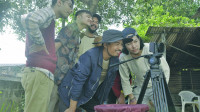Entertainment
‘Qatar is like a piece of abstract art’
On Sunday, as part of its weekly event Sunday Cinema, the Film Critics’ Society of Nepal (Ficson) screened the documentary The Desert Eats Us, at the Union House in Anamnagar.
Timothy Aryal
On Sunday, as part of its weekly event Sunday Cinema, the Film Critics’ Society of Nepal (Ficson) screened the documentary The Desert Eats Us, at the Union House in Anamnagar.
Directed by Kesan Tseten, the film revolves around the stories of Nepali migrant workers residing in the gulf country of Qatar. The film, which weaves into its narrative roughly dozen stories of the workers working therein, is about how the desert metaphorically eats up Nepali migrant workers, and, deeply unsettlingly, sometimes literally as well.
The film has as its subjects, among others, journalist Devendra Bhattarai (who, at the time the film was shot, was the co-ordinator of Kantipur national daily’s weekly Qatar supplement), and Sagar Nepal, who, unlike many other workers, was maintaing a decent living in the country.
In one harrowing episode that journalist Bhattarai recounts towards the end of the film, he tells us how one Nepali worker was killed in his room, part of his body eaten later, by his own (non-Nepali) roommates. “It’s unbelievably tragic. I don’t know what to make of it. I can’t believe if the incident actually happened. It is settled in the back of my mind like a myth,” Bhattarai says of the event.
In another episode, a Nepali is stranded in the country. He visits the Nepali Embassy in search of help. Does he know the whereabouts of the agent who sent him to Qatar? No. Does he know the name of company he was promised to be working? No.
“Things like this are commonplace in Qatar. It obviously shows the lack of awareness among the émigrés. There are several instances where a worker is betrayed by his own family members. A brother selling an invalid visa to his own brother, a brother-in-law duping his wife’s sister—things like this keep happening,” Bhattarai says.
Then there are the usual episodes where the workers are compelled to work and live in inhumane conditions. In another of the many moving instances in the film, Bhattarai visits a worker’s dormatory, where some four people are residing in a dingy, cramped dormatory. When Bhattarai asks them if their room is furnished with an AC, one of them jokingly says, “Yes, it’s all around us, in all of the four walls.”
The documentary was shot in the year 2010. Have things changed now? Journalist Hom Karki, who succeeded Bhattarai as Kantipur’s Qatar bureau co-ordinator, in a discussion after the screening, said, “Sure, things have changed, albeit slowly, for the better. But the core problems are still the same. For example, there are prejudices regarding salaries alloted to Phillipini or Sri Lankan workers and Nepali workers. If a Philipino earns, say, 1,000 Riyals for the same work, Nepalis earn only 600. If Nepalis work for eight hours straight, Sri Lankan work for only four, and still get the same amount, if not more.”
Kesang Tseten, the director of the film, speaking at the event, said that, despite his genuine efforts to narrate the story as it is, there were many obstacles he had to overcome. “Journalists try to uncover the reality through reporting, we do through filming. In a country like Qatar, to uncover the reality comes with its own risks. The moment the authorities find out we were filming, we would be in trouble. So it was not easy.”
In journalist Bhattarai’s view, “Qatar is like a piece of an abstract art. You can’t exactly pin down what it is.”
The screening comes at a time when seven countries, most of them Arab nations including Saudi Arabia, have severed diplomatic ties with Qatar, exposing the deepening rift in the Gulf and leading to a major regional crisis. And the real pawns in this geopolitical game stand to be ordinary citizens, especially foreign workers including more than 400,000 Nepalis based in the tiny Gulf nation.




 23.12°C Kathmandu
23.12°C Kathmandu










